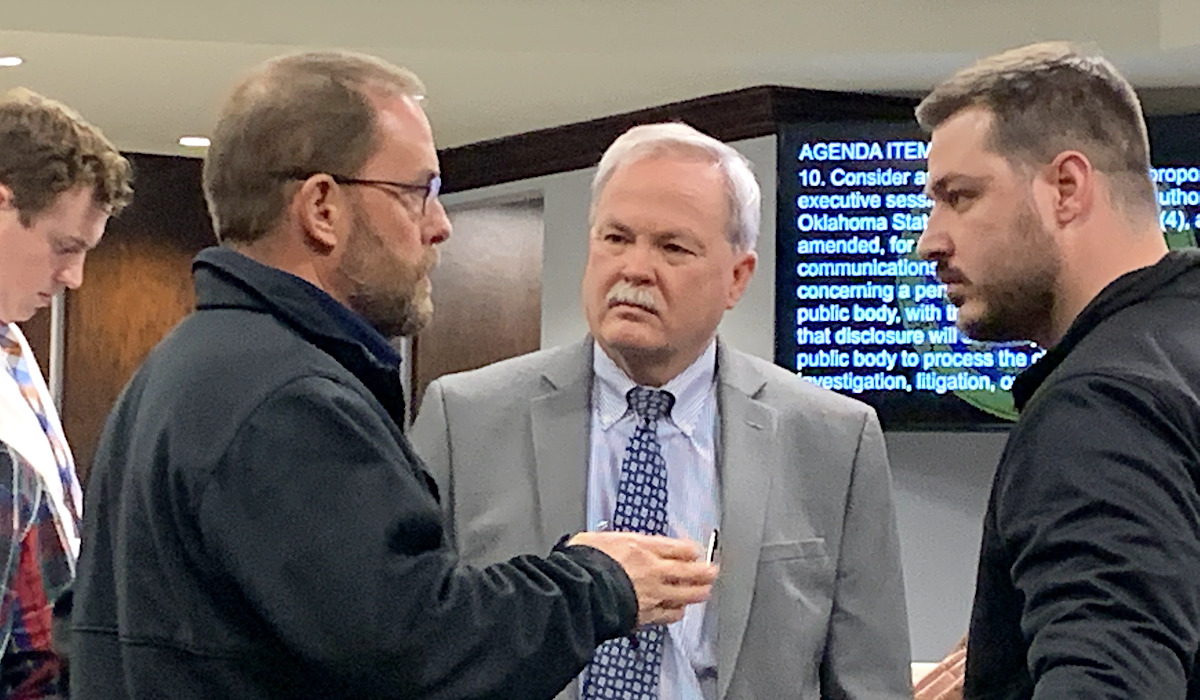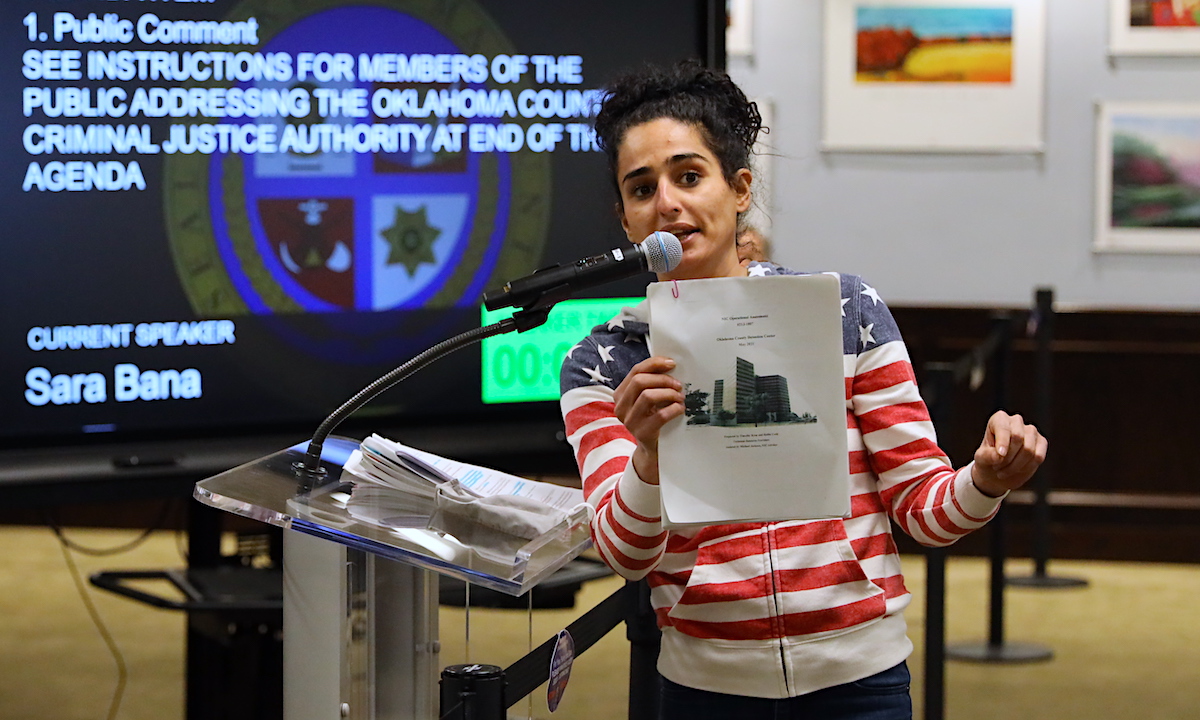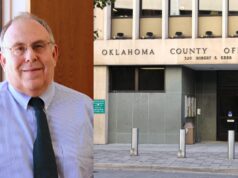
In its 15-page final report, the state multi-county grand jury that spent 14 months hearing testimony about the Oklahoma County Criminal Justice Authority and the Oklahoma County Detention Center recommends the jail trust “self-terminate” and that daily operations be returned to the County Sheriff’s Department.
No individuals were indicted by the multi-county grand jury, and so far no charges have stemmed from the investigation, which was led by Cherokee County District Attorney Jack Thorp following the recusal of former Oklahoma County District Attorney David Prater, who originally requested the inquiry.
Called the “jail trust,” the OCCJA took over daily administration of the long-beleaguered Oklahoma County Jail from the county sheriff in 2020. In that time, 37 detainees have died, and questions have arisen about the trust’s ability to operate the facility. From the grand jury’s perspective, those questions have been answered.
“Based upon the review of the OCDC and the OCCJA, the MCGJ recommends that the OCCJA self-terminate, that the governor approve this termination, and that supervision of the jail be returned to the Oklahoma County sheriff,” the report states.
Members of the grand jury, which meets for 18-month terms to assist in a variety of criminal investigations involving law enforcement agencies across the state, recognized some improvements in the jail but declined to assign credit for those improvements to the trust’s actions.
“It appears that, in some regards, improvements have been made to jail operations,” the report states. “However, those improvements do not appear to be related to the OCCJA. It seems more likely that they are the result of greater amounts of money dedicated to facility improvements.”
Ben Brown, the current chairman of the jail trust, declined to comment on the report when reached by phone Thursday evening, but a statement from him was included in a press release from the jail’s administrator.
“The jail trust cooperated with the Grand Jury investigation and will carefully review the report,” Brown said. “The members of the trust and new management at the jail will continue our work to improve jail operations.”
Trustee Sue Ann Arnall said she would prefer that the trust remain in place and continue to oversee the jail’s operations rather than dissolve itself as the grand jury report recommends. Arnall has also pushed for detainees to have more time outside their cells, which is something she said could be in jeopardy if the trust were to dissolve.
“The trust has to approve it as a majority,” Arnall said. “If we did go back to the sheriff, he still has a lot of people who ran the jail in the past on staff, and they didn’t think it was possible or proper for people to be out of their cells for six or eight hours a day. But with this new administrator and staff, people are out of their cells four to six hours a day, and it’s going to go up. It’s created a different culture in the jail. It’s a huge improvement. When people are out of their cells, there is not as much depression. We’ve started new programs that weren’t possible before.”
Arnall said the trust has had a better relationship with new Oklahoma County District Attorney Vicki Behenna than it did with Prater, who was publicly critical of the jail’s operation and the trust. Prater requested and later recused himself from the grand jury’s proceedings.
In the report, grand jurors investigated claims that Prater had pressured the Oklahoma State Department of Health to be tougher on the jail during its inspections. The grand jury found no evidence of that. But Arnall said more detainees have received medical OR releases since the change in DA.
“With the medical evaluation we can bring them in and reject them if they are too sick and the police will take them to the hospital,” Arnall said. “The former DA would not give us any medical ORs. Between him and Judge (Ray) Elliott, we got maybe two medial ORs, and we submitted something like 83. Since we’ve had the new DA we’ve been getting more medical ORs. That’s another reason why we’ve seen fewer deaths.”
Prater dismissed those concerns Friday.
“That is an absolute inaccurate and irrelevant comment,” Prater said Friday afternoon. “The grand jury’s report speaks clearly as to the cause of the deaths they were concerned about, and medical ORs were not mentioned.”
Prater expressed frustration at “the inaction of the jail trust board members to prevent the jail deaths.”
“They’ve had the power to do something, and they’ve done nothing,” he said.
Trustee Derrick Scobey said he would defer to his comments made in the Dec. 5 meeting of the jail trust when former jail CEO Greg Williams resigned.
“We now have to turn the scope away from whomever else and we have to aim it at ourselves,” Scobey told fellow trustees in that meeting.
Scobey, who is a current candidate for Oklahoma County clerk, said that if the trust can’t do a better job running the jail, then it’s time to turn it over to someone else.
“If we don’t get it right and get it right quickly, then the Oklahoma County Criminal Justice Authority — also known as the Oklahoma county jail trust — should be dissolved,” he said in the Dec. 5 meeting.
In a text message Thursday night, Scobey said he stood by those comments.
Oklahoma County Criminal Justice Advisory Council executive director Tim Tardibono said he was disappointed in the grand jury’s recommendation that the trust dissolve itself.
“Despite the numerous areas of agreement with the report, we must strongly disagree with the recommendation that the trust should end,” Tardibono said in a statement. “The report did not even mention the 1995 grand jury report that specifically called for a trust and for the sheriff to not run the jail. Additionally, two other task forces in 2002 and again in 2008 both strongly called for a trust. It’s unclear why more than two decades of support for a trust was left out of the report.”
Grand jury recommends against closure
The grand jury report also notes that the jail has long been out of compliance with Oklahoma State Department of Health inspection protocols and that, in theory, the department could move to close the facility with the governor’s approval.
However, the grand jury did not recommend closing the current facility in its findings. Funding for a new $297 million jail was approved by county voters last year, but that facility will not open for several years.
Key sections of the multi-county grand jury report focus on:
- A 2008 U.S. Department of Justice memorandum of understanding
- The creation of the jail trust
- Evaluations from the State Department of Health
- Financial irregularities with use of the CFO’s personal credit card
- Deaths at the Oklahoma County Jail
- Hiring issues at the facility
- Criminal investigations within the jail
- An alleged real estate development conspiracy
- Potential obstruction of district attorney
- A 2022 Drug Enforcement Administration investigation at the jail
- Use of ARPA funds
The full grand jury report on the Oklahoma County Jail is embedded below.
Inaction of former CEO Greg Williams cited

Jurors criticized the tenure of former jail administrator Greg Wiliams who resigned in December.
“The MCGJ finds that the former chief executive officer of the OCDC did not take proactive or effective steps to curb the significant death rate in the jail,” the report states. “The MCGJ believes that inadequate staffing, funding, surveillance, and training, coupled with poor law enforcement protocols, led to the significant loss of life within the jail. Discussion of protocols is reserved within the section of this report regarding criminal investigation; however, an effective and interested administration should have taken more proactive steps to address these obvious problems in the jail. This is especially true considering the significant number (37) of deaths in the jail since management of the jail shifted from the Oklahoma County Sheriff to the OCCJA on July 1, 2020.”
The grand jury report blames inadequate screening for the pervasiveness of opioids inside the facility. According to the report, members of street gangs were hired as detention officers.
“The jury has also learned that background checks have been limited, in the interest of filling positions. Members of organized criminal gangs have been able to secure employment as detention officers and have aided in the introduction and distribution of controlled dangerous substances within the jail, leading to loss of life and requiring lifesaving use of Narcan to resuscitate persons overdosing on opioids,” the report states. “It is troubling to the MCGJ that, according to the testimony of witnesses, administrative staff were warned and allegedly ignored concerns by some investigative staff that criminal street gang members were being hired as detention officers.”
It also recommends the facility hire 100 more detention officers in order to operate the facility safely. At the March meeting of the trust, new jail administrator Brandi Garner said the facility has just under 300 employees. Jurors also recommended a higher starting salary for new employees to improve recruitment and retention.
‘No evidence of wrongdoing was discovered’ on jail relocation

With the approval of $260 million in bonds by voters last year, a site for the new county jail has yet to be determined, although potential locations have been floated. The grand jury received an allegation of a conspiracy between community members involving the jail’s relocation.
“It was alleged that the conspiracy was linked to the campaign that ultimately led to passage of the $260 million bond issue that put into place funding for a new Oklahoma County Jail,” the report states. “According to information provided to the MCGJ, the reasoning behind the bond issue was that the current site of the OCDC would be an excellent site for real estate revitalization in downtown Oklahoma City, that the OCDC’s location depressed the area in downtown Oklahoma City, and that its removal would lead to a construction boom for real estate developers, who saw the relocation of the OCDC as a way to develop the site, and potentially make significant profit for the development.”
The OSBI also reviewed the allegations and found no evidence of wrongdoing, according to the grand jury report.
“After a thorough investigation by the OSBI, including consultation with developers, county officials, and members of community action coalitions, no evidence of wrongdoing was discovered,” the report states. “The MCGJ determined that the area surrounding the OCDC is currently under development. The MCGJ found that, should the OCDC be relocated to an area outside the downtown Oklahoma City area, the property would likely be sold by Oklahoma County in the manner prescribed by law.”
Potential obstruction of justice detailed
In one section of the report, potential obstruction is mentioned by grand jurors in reference to the Oklahoma County Detention Center’s in-house attorney modifying reports that were later submitted to police, which potentially restricted information to investigators.
“The MCGJ considered these allegations about OCDC nhouse attorney and did not determine whether these allegations were ‘obstruction’ per criminal statutes,” the report states. “Clearly OCDC inhouse attorney has a duty to represent a client — in this case the OCDC, and specifically those individuals in an administrative capacity that he has a duty to advise in that circumstance. However, modification of police reports (if true) or willfully restricting access to information necessary for a prosecutor to make a charging decision could be considered obstruction.
“The MCGJ invites additional information and investigation into these allegations and requests [DA Jack Thorp] to refer this potential ‘obstruction’ to the OSBI for further investigation, and at the completion of the investigation consult with Oklahoma Attorney General and Oklahoma County District Attorney as to jurisdiction for the potential of filing charges by criminal information.”
Bana: ‘I can’t think of a corruption case that has been as deadly as this one’

The People’s Council for Justice Reform is an activist group that sprung up following the trust’s takeover of the jail in 2020. Group member Sara Bana told NonDoc she is pleased that the grand jury report was thorough and detailed, but she said she was surprised no one was indicted in connection with the 37 deaths at the jail.
“It’s sort of insult to injury for the many victims and survivors’ families that the multi-county grand jury didn’t go as far as making any indictments,” she said. “They instead identified and deferred to agencies that should pursue possible charges. I can’t think of another case of corruption that has been as deadly in Oklahoma as this one.”
With the grand jury’s work concluded, Bana said she hopes Attorney General Gentner Drummond will continue to investigate the jail.
“There hasn’t been the level of accountability when there was criminal negligence that resulted in preventable deaths,” Bana said.
Criminal justice activist Jess Eddy also frequently speaks at jail trust meetings. Eddy said he hopes the jail trust continues its management of the facility while expressing concerns over returning it to the sheriff.
“The formation of a public, citizen-comprised board to oversee the jail — holding regular public meetings with public comment — has afforded the community drastically improved access and means of accountability,” Eddy said Friday. “The idea that a return to law enforcement control is a good step contradicts the history of how we got to a jail trust in the first place. To suggest we had any meaningful access or means to hold sheriffs accountable in the past is asinine.”





















